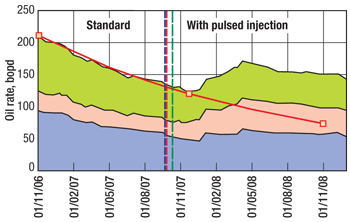|
Vol. 231 No. 11 |

|
|
HENRY TERRELL, CONTRIBUTING NEWS EDITOR
|
Shaking things up a bit
On March 27, 1964, Good Friday, at a little past 5:30 in the afternoon, the largest earthquake ever recorded in North America, and the second-largest in the world, rippled across south-central Alaska. Measuring 9.2 on the Moment Magnitude scale (similar to the old Richter scale), the quake caused more than 130 deaths, the great majority from the tsunamis that followed. Damage was extremely heavy and widespread, and vast areas of land permanently changed in elevation.
 |
Pulse stimulation tools installed in three existing waterflood patterns in an Alberta oil field improved production about 85 bpd above baseline, for a total incremental volume of 20,000 bbl. Courtesy of Wavefront.
|
|
Over the following days and weeks, some 10,000 aftershocks were measured across Alaska and Western Canada. Production from both water wells and oil wells fluctuated significantly, and continued changing for several weeks. It was clear that previously immobile oil was being shaken loose.
Although the Alaska example was one of the most dramatic, the phenomenon of increased (or decreased) production following seismic events was well-known since the early 1950s. In Russia, China, Canada and the US, seismic waves from earthquakes or so-called “cultural noise” (i.e., trains, highways, industrial engines) had been shown to sometimes improve the mobility of oil in place. Results were erratic and difficult to predict, but it was obviously worth pursuing.
Left behind. Primary (pressure depletion) and secondary (waterflooding) production methods can recover only 20–40% of the original oil in a reservoir. Enhanced oil recovery—gas, chemical, microbial or thermal—can improve production to 60% or more. That leaves a lot of crude behind. The Department of Energy has estimated that over 374 billion bbl of oil remain unrecovered in US oil wells, even after enhanced recovery methods have been exhausted.
The most likely potential customers for seismic wave stimulation are depleted wells that have a lot of immobile oil and high watercut, a description that fits many mature fields around the world. In the 1950s, anecdotal evidence of increases in pore pressure resulting from earthquakes and trains led Russian scientists to experiment with vibroseismic stimulation. While there were encouraging results, in some cases oil production actually dropped or ceased. Research over the next three decades produced a better understanding of the phenomenon. A variety of techniques and wave types were tested, using frequencies from 1 Hz to
5 MHz. Knowledge improved, but commercial applications were elusive.
The US Department of Energy’s National Petroleum Technology Office funded two projects in the 1990s. Los Alamos National Laboratory and the Lawrence Berkeley National Laboratory, along with academic and industry partners, set out to study how and under what circumstances low-frequency stress (defined as seismic or acoustic waves of 1–500 Hz) can enhance production in depleted fields. Research was divided into lab experiments using cores, theoretical modeling of two-phase fluid flow, and field tests. These field tests produced an enormous range of results that proved very difficult to predict.
How does vibration help? The actual physical changes that cause oil to flow more freely are not fully understood. Several mechanisms have been suggested: Saturated oil may become more “water-wet,” viscosity may drop, or surface tension may be reduced. It has been postulated that seismic vibration may cause microdrops of oil to coalesce, leading to improved flow, and may also break loose the boundary layers on the pore walls. Some methods have been shown in the laboratory to greatly increase permeability during vibration, but the beneficial effect disappears soon after vibration ceases.
Feel the pulse. Another approach is fluid pulse stimulation. This is vibration in a different form. In an earthquake, several different wave forms are produced, the majority of which are shear waves and compression waves. These compression waves move through the ground at something like 2,300 m/sec. A tsunami, on the other hand, is a bulk movement of fluid from one point to another, and travels at a much slower 100–300 m/sec.
Wavefront Technology Solutions of Alberta, Canada, has developed the Powerwave process, which introduces a tsunami-like wave form into the formation to move injection fluid and give it better distribution. Wavefront’s CEO Brett Davidson compared the process to putting a kink in a garden hose. Energy is stored up behind the kink, and when it is released, the stream of water suddenly accelerates and returns to a steady state. The mechanism is similar to a heartbeat, but instead of expanding and contracting capillaries to move blood, the pulses expand and contract porous rock to move fluids.
“With an injection well, you have a pump on the surface that supplies pressure,” said Davidson. “If you have a valve downhole that opens and closes, you get bursts of fluid that have momentum. This allows more pore spaces in the formation to accept liquid. The fluid could be water, CO2 flood, polymer or surfactant, or it could be used in an acid job.”
With better distribution of liquid, you reach more stranded and bypassed oil, and the more contact with that oil, the more of it is mobilized into the mainstream flow. The tool emits pulses at a “repetition rate” between 20 and 40 per minute, adjusted for injection rate and formation characteristics.
The technology has been utilized in more than 175 well applications in North America, including Alberta, California, Oklahoma and West Texas. The longest-running case history, in Alberta, has been going on for three years (see figure). Before treatment, production declined an average 3.4% per month. Since pulse stimulation began, the decline has averaged just 0.2% per month. 
|




